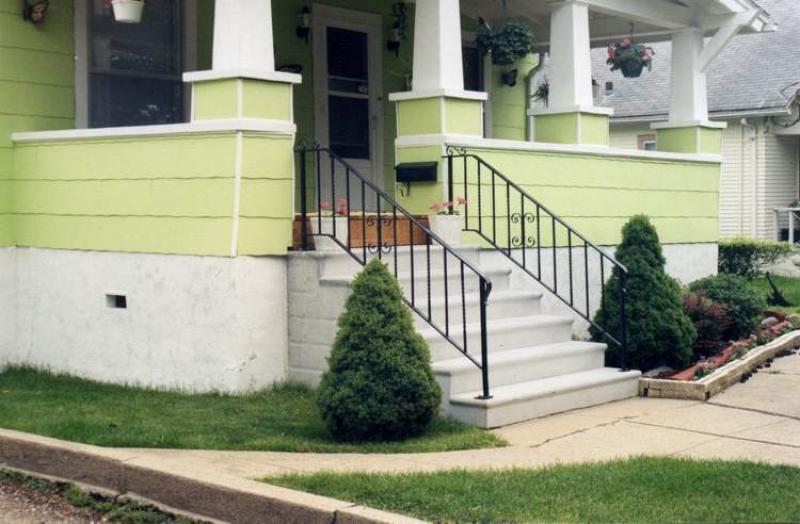QUESTION: I am hoping that you may be able to provide an opinion on this problem. My house is just seven years' old and I have been trying to contact the builder over the last few weeks, but they will not return my calls.
During the last hot summer, my front yard sunk about eight inches, leaving a large gap between the front stairs and the ground. As these are precast steps I assume they are attached to the foundation and are supporting the weight of the porch roof and columns.
Should the steps be supported by the ground or at least with jacks underneath? I do not want to risk the steps cracking or separating from the house. I have wood on the side of the steps to keep the granite stones from falling under the steps.
Any advice you could give would be appreciated. Thanks, Robert Huyghe
ANSWER: You might be correct that the precast steps are secured to the foundation, but they may also be supported underneath if they have a roof above. If that's indeed the case, you will have little to worry about except filling in the void under and in front of the steps.
I'm not surprised that the builder will not return your call, as most want little to do with homeowners after the one-year portion of the warranty has passed. After the total expiration of the warranty, often five years, many builders don't want to hear from you unless you want to buy another home. After that, they may be able to provide you with a plan or details that confirm my suspicion that the steps are properly supported with a concrete pier or other structure to prevent sinking, but that's about all.
I think that is what you may discover, because stairs simply pinned to the foundation of a newer home with bolts would not likely have sufficient strength to support the roof above. They may have support not visible below grade, either extending out from the foundation or buried deep in the soil.
If you can't get this reassurance from the builder and you can't physically see the stair-support mechanism, you may be able to find out from the municipal building department. For newer homes, they'll likely have a copy of the plan on file. While this is not a certainty, a call to your local city or town inspection branch may provide the answer you seek.
You may have to pay a nominal search fee to see a copy of the permits, inspection information and plans, but it's probably worth the effort. If a copy of the plan is on file, even if it is just a basic plan including foundation details, you should be able to see how the steps are supported. There may be round piers drawn on the plan outside the foundation where the steps are to be placed. Alternatively, there may be a concrete grade beam or other extension of the foundation visible that provides the needed support.
If this is not seen on the plan, there may be a detail for securing the steps to the foundation. If none of these items are specifically addressed in the detailed drawings, you may have reason to explore your suspicions further.
If the soil has not settled enough that you can physically see the stair support while laying on the ground, a little excavation may be required. Since the soil in the area around the stairs needs to be built up, it should not cause major disruption to dig down a short way under the edge of the stairs to look for the support.
If you do this, you may see either the top of a concrete pier in one or both front corners of the stairs where the roof columns rest. Alternatively, there may be a small concrete grade beam or triangular supports extending out from the foundation of the house. You may need a good flashlight and mirror to see these items, but you should be able to easily confirm if they're in place. If you dig all around the front and exposed sides of the stairs and don't see any physical support, then additional work may be warranted.
Filling in under the steps to prevent seepage through the foundation in this area is a must. If you've already dug down below the steps to look for the support mechanism, this should allow you easier access for backfilling. You should shovel as much fill as possible under the hollow stairs as it will settle and compact over time. This fill could be topsoil, sand, small stones or a mixture of these materials, as long as it stays in place when piled under the steps.
Once this is complete, mixed soil can be spread in front and around the steps and foundation to raise the grade back to a reasonable height. Planting grass seed or sod on top of this new soil will help prevent further erosion and will help the fill under the stairs from disappearing again.
If you're convinced, after following these steps, that there is not a proper structure supporting your front steps, you should call in the professionals. A reputable foundation contractor should be hired to underpin the steps, or provide alternative methods to prevent sagging of this and the roof above.
But if proper supports are exposed or verified, as I suspect they will be, you need only return the grade to the previous level with some timely landscaping to prevent further problems.
Ari Marantz is the owner of Trained Eye Home Inspection Ltd. and the president of the Canadian Association of Home & Property Inspectors - Manitoba (www.cahpi.mb.ca). Questions can be e-mailed to the address below. Ari can be reached at (204) 291-5358 or check out his website at www.trainedeye.ca.
trainedeye@iname.com




